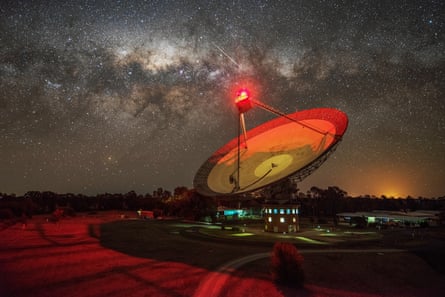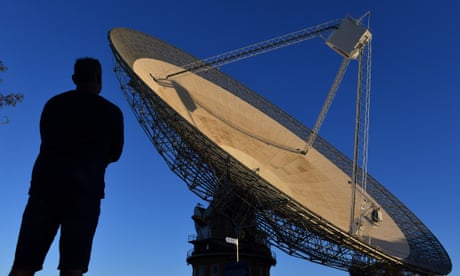Extract from The Guardian
A CSIRO team at Murriyang has been tracking millisecond pulsars for 18 years and say they have evidence supporting the existence of gravitational waves.
Supported by
Last month, astronomers found the strongest evidence yet for gravitational waves. First theorised by Albert Einstein in 1915, a high-frequency “chirp” of colliding black holes was observed in 2016. But the ultra-low-frequency waves of pairs of black holes orbiting each other had not been observed until recently.
CSIRO scientists working at Murriyang have been observing an array of nano hertz frequency pulsars for almost 20 years. They are ripples in space time that are nearly the same size as the Milky Way.
The longevity of the experiment is due to the waves being years or even decades in length.
Dr Andrew Zic, a research scientist at the CSIRO who has been involved in the project for the past three years, says in June they found the strongest evidence yet that the Parkes Pulsar Timing Array and other teams around the world had seen hints of the gravitational waves in their datasets.
Evidence of gravitational waves is significant because until now, most observations of the universe have involved different forms of light, such as X-rays and radio waves.
“Gravitational waves are a completely different way of looking at the universe,” Zic says. “With this emerging evidence we’re seeing, we’re now opening a completely new window into the universe that is inaccessible any other way.”

Zic says the gravitational waves observed about seven years ago by the Laser Interferometer Gravitational-Wave Observatory (Ligo) scientific collaboration were very different from those picked up on the Parkes array.
“We are seeing something on a much larger scale, and that is really exciting because it’s a new window on the universe,” he says. “We’ll be able to learn a lot about the evolution of galaxies, and potentially in the future learn more about the structures and quantum fluctuation left over from the big bang.”
The Parkes telescope has played a major role in astronomical discoveries because it is one of the largest single-dish telescopes in the southern hemisphere.
“The centre of the Milky Way is located in the southern sky,” says Zic. “So because we are in the southern hemisphere, we’re actually the best place to observe all sorts of objects in the galaxy.”
That includes the millisecond pulsars that are evidence of gravitational waves.
“Parkes plays a really important role, because of that long timespan of observation of these millisecond pulsars that we’ve taken over 18 years in the southern hemisphere that other telescopes that are bigger and more sensitive, but are in the northern hemisphere, can’t access.”
Parkes was chosen for the placement of the dish in the 1950s because it was relatively close to Sydney – just 355km away – yet was far enough that there was little radio interference. Construction was completed in 1961.
John Sarkissian, an operation scientist at the CSIRO Parkes Observatory who has been working at the dish since 1996, says before the dish was built, very few people had appliances and electrical equipment that generated any signals that could interfere with what they were trying to observe.

“In those days, local farmers probably had a valve radio, a generator or the house lights, but that was about it,” he says.
Since then, conditions of radio silence have “deteriorated”.
“Everyone now has mobile phones, digital radio, TV, computers, videos, heart pacemakers, computers in your cars, laptops, you name it,” Sarkissian says. “But compared to other sites of similar vintage, it’s still quite good. And we can still do work here – world-class work.”
In the near future, Sarkissian hopes they will repeat the task they performed in the Apollo lunar missions by tracking Nasa’s first commercial moon landing.
The dish was only meant to last two decades, but Sarkissian says it survived multiple upgrades due to the structure being “built much more solidly than it needed to have been”. The upgrades – including new surface panels and a new focus cabin – mean Murriyang will remain operational for at least another 20 years.
“The telescope today is over 10,000 times more sensitive than when it was built back in 1961,” Sarkissian says.



No comments:
Post a Comment